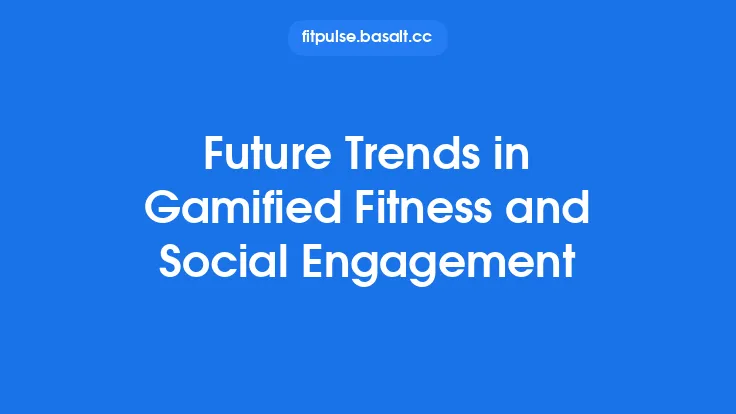Artificial intelligence has become a cornerstone of modern fitness coaching, offering personalized insights that were once only possible through one‑on‑one sessions with human trainers. While the benefits are clear—more tailored guidance, continuous monitoring, and scalable support—the rapid adoption of AI‑driven fitness platforms also raises profound ethical and privacy questions. Users entrust these systems with intimate details about their bodies, habits, and health status, and developers must navigate a complex landscape of data stewardship, algorithmic fairness, and regulatory compliance. This article explores the core ethical considerations and privacy challenges inherent to AI fitness coaching, offering a roadmap for responsible design, deployment, and ongoing governance.
Data Collection and Types of Data
AI fitness coaches rely on a broad spectrum of data to generate personalized recommendations:
| Data Category | Typical Sources | Sensitivity Level |
|---|---|---|
| Physiological Metrics | Heart‑rate monitors, VO₂ max estimations, sleep trackers | High (potential health indicators) |
| Activity Logs | Step counts, workout duration, GPS routes | Medium (reveals daily routines) |
| Biometric Identifiers | Fingerprint, facial recognition for device login | High (unique personal identifiers) |
| Self‑Reported Information | Goal statements, injury history, dietary preferences | Medium‑High (subjective health data) |
| Contextual Data | Device type, operating system, location timestamps | Low‑Medium (metadata) |
Understanding the granularity and sensitivity of each data type is the first step toward establishing appropriate privacy safeguards. Not all data are equally risky; however, even seemingly innocuous metrics can become identifying when combined (the “mosaic effect”).
Informed Consent and User Autonomy
1. Granular Consent
Rather than a single “accept all” checkbox, platforms should enable users to consent to each data category separately. For example, a user may allow activity logs but decline sharing precise heart‑rate variability.
2. Ongoing Consent Management
Consent is not a one‑time event. Users should be able to review, modify, or withdraw permissions at any moment through an intuitive dashboard.
3. Clear Language
Legal jargon obscures understanding. Consent dialogs must use plain language, explicitly stating:
- What data are collected
- How the data will be used (e.g., personalization, research, third‑party services)
- Retention periods
- Potential risks
4. Opt‑Out Mechanisms
If a user opts out of a specific data stream, the AI should gracefully degrade its functionality rather than forcing continued participation.
Data Security and Storage Practices
Encryption at Rest and in Transit
All data, especially physiological metrics, should be encrypted using industry‑standard algorithms (e.g., AES‑256) both while stored on servers and during transmission (TLS 1.3 or higher).
Zero‑Trust Architecture
Adopt a zero‑trust model where every request—internal or external—must be authenticated and authorized, minimizing lateral movement in case of a breach.
Secure Key Management
Encryption keys must be stored in hardware security modules (HSMs) or cloud‑based key management services with strict access controls.
Regular Audits and Penetration Testing
Periodic third‑party security assessments help uncover vulnerabilities before malicious actors exploit them.
Anonymization, Pseudonymization, and the Mosaic Effect
Pseudonymization replaces direct identifiers (e.g., name, email) with a reversible token, allowing data to be linked back to the user under controlled conditions. Anonymization removes or transforms data so re‑identification is practically impossible.
However, fitness data are highly granular; combining location, activity patterns, and biometric signatures can inadvertently re‑identify individuals. Effective mitigation strategies include:
- Differential Privacy: Adding calibrated noise to aggregated datasets to protect individual contributions while preserving overall utility.
- Data Minimization: Retaining only the data necessary for a given purpose and discarding the rest after the retention period.
- Aggregation Thresholds: Reporting statistics only when a minimum number of users contribute, reducing the risk of outlier identification.
Algorithmic Bias and Fairness
AI models trained on fitness data can inherit biases present in the training set:
- Demographic Imbalance: If the dataset over‑represents certain age groups, genders, or body types, the model may produce less accurate recommendations for under‑represented users.
- Cultural Context: Exercise norms differ across cultures; a model that assumes a “standard” routine may inadvertently marginalize users with alternative activity patterns.
- Health Status Bias: Users with chronic conditions may be excluded from training data, leading to recommendations that are unsafe or ineffective for them.
Mitigation Approaches
- Diverse Data Collection – Actively recruit participants across age, gender, ethnicity, fitness level, and health status.
- Bias Audits – Conduct regular fairness assessments, measuring performance disparities across demographic slices.
- Explainable AI (XAI) – Provide users with understandable rationales for recommendations, enabling them to spot potential bias.
Transparency and Explainability
Users deserve to know why an AI coach suggests a particular intensity, rest interval, or recovery strategy. Transparency can be achieved through:
- Model Cards – Documentation that outlines model purpose, training data, performance metrics, and known limitations.
- User‑Facing Explanations – Simple visual cues (e.g., “Your recent heart‑rate variability suggests a higher recovery need”) that link data inputs to output decisions.
- Open APIs for Auditing – Allow third‑party auditors to query the system for decision pathways without exposing raw user data.
User Control Over Data Lifecycle
1. Data Portability
Enable users to export their data in a standard format (e.g., JSON, CSV) for personal archiving or migration to another service.
2. Right to Erasure
Implement a “Delete My Data” function that removes all personal records from active databases and backups within a defined timeframe (e.g., 30 days), complying with regulations such as GDPR.
3. Versioning and Auditing
Maintain immutable logs of data access and modifications, giving users a transparent history of how their information has been used.
Regulatory Landscape and Compliance
| Regulation | Jurisdiction | Key Requirements for AI Fitness Coaching |
|---|---|---|
| GDPR | EU | Lawful basis for processing, data minimization, explicit consent, right to access/erasure, Data Protection Impact Assessments (DPIA) for high‑risk processing. |
| CCPA/CPRA | California, USA | Right to know, right to delete, opt‑out of sale, non‑discriminatory service provision. |
| HIPAA (if health‑related data are shared with covered entities) | USA | Safeguards for protected health information (PHI), Business Associate Agreements (BAAs). |
| PIPEDA | Canada | Consent, transparency, data accuracy, security safeguards. |
| AI Act (proposed) | EU | Classification of AI systems by risk, mandatory conformity assessments for high‑risk AI (which may include health‑related coaching). |
Compliance is not a one‑size‑fits‑all checklist; it requires a privacy‑by‑design mindset, integrating legal requirements into the architecture from the outset.
Best Practices for Developers and Service Providers
- Privacy‑by‑Design Frameworks – Adopt standards such as ISO/IEC 27701 (Privacy Information Management) and embed privacy controls early in the development lifecycle.
- Data Governance Boards – Establish cross‑functional committees (legal, technical, product, ethics) to oversee data handling policies.
- User‑Centric Privacy Settings – Default to the most privacy‑preserving configuration; allow users to “opt‑in” to additional data sharing.
- Continuous Monitoring – Deploy automated tools that detect anomalous data access patterns, potential breaches, or policy violations in real time.
- Education and Communication – Provide clear, accessible resources (FAQs, tutorials) that help users understand privacy implications and how to manage their settings.
Future Outlook and Ongoing Challenges
Even as privacy regulations mature, new technical and societal challenges will emerge:
- Federated Learning – Training models on‑device without transmitting raw data can reduce exposure, but still requires careful handling of model updates that may leak information.
- Synthetic Data Generation – Creating realistic yet non‑identifiable datasets for research, though ensuring synthetic data do not inadvertently encode real user traits remains an open problem.
- Cross‑Platform Data Sharing – Users often employ multiple fitness apps; establishing interoperable privacy standards across ecosystems is essential to prevent “privacy leakage” through data aggregation.
- Ethical AI Governance – Beyond compliance, organizations are expected to adopt ethical AI principles, including fairness, accountability, and societal impact assessments.
Addressing these issues will demand collaboration among technologists, ethicists, regulators, and the fitness community itself.
Conclusion
AI fitness coaching offers unprecedented personalization, but its promise hinges on the trust users place in the systems that collect, analyze, and act upon their most personal data. By foregrounding informed consent, robust security, algorithmic fairness, and transparent governance, developers can build platforms that respect user autonomy while delivering meaningful health benefits. As the field evolves, continuous vigilance—through technical safeguards, ethical oversight, and regulatory alignment—will be essential to ensure that the pursuit of peak performance never comes at the expense of privacy and ethical integrity.




